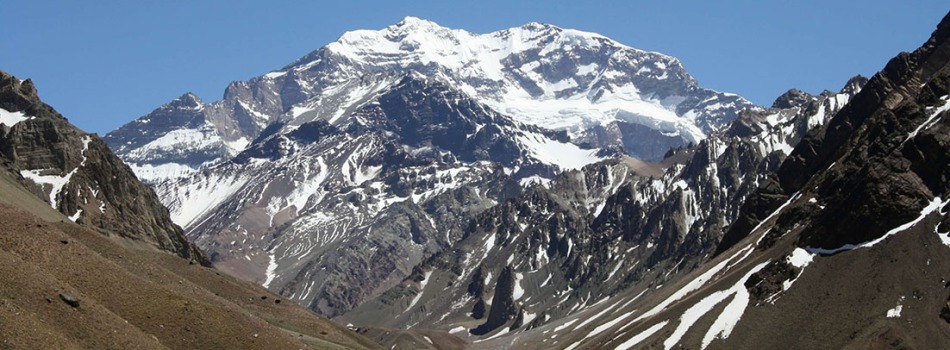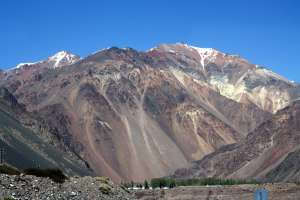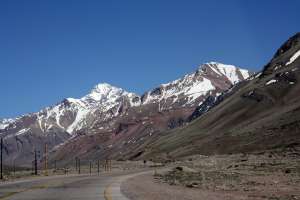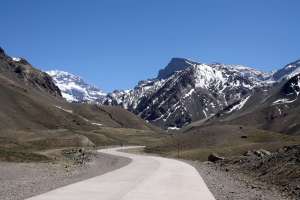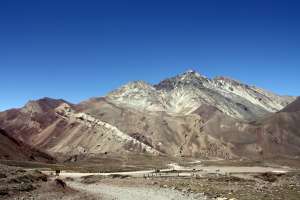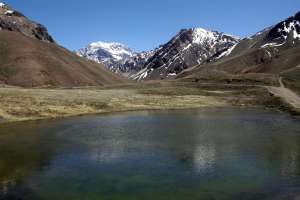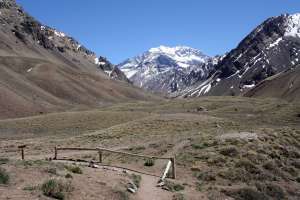She spoke only Spanish. I spoke only English. She was my driver, focused on navigating the two-lane road coursing through the foothills of the Andes Mountains in western Argentina. I was the passenger mesmerized by beguiling landscapes.
Through an unfortunate snafu, my request for an English-speaking driver to shuttle me to and from Aconcagua Provincial Park didn’t pan out. There was no time to reschedule; it was my last day in Mendoza before returning to Buenos Aires. So, with some trepidation, I slid into the passenger seat beside Soledad and girded myself for a 100-mile drive with someone with whom I could barely communicate.
As we emerged from the fringes of the city, I butchered some rudimentary Spanish and floated some much-better Italian that might have sufficed in its relation to its cousin language. Her responses were curt, not unfriendly but fairly short. Either my cacology was worse than I imagined and she found my rudimentary efforts inscrutable and figured one-word answers were best, or maybe she was inherently taciturn. Or perhaps she just disliked me.
Whatever the reason, I soon abandoned my abortive attempts. Soledad and I eventually settled into a comfortable silence on our journey from Mendoza to Aconcagua Provincial Park, a 162,000-acre wonderland just 10 miles from the Chilean border. Ridiculously slanted mountains soon began to spring up from the floor of Uspallata Valley—some disarmingly smooth, others forbiddingly rugged, in uncountable gradations of earth tones. The farther we went, the higher the mountains rose and the more desolate the landscape became, with nothing around but some brush, a stray alpaca, a rusting trestle bridge, and a minuscule village or two that looked more like a handful of outbuildings at a military post than a place you could ever imagine calling home.
The Incas were the first to populate the valley, living off a survival agricultural economy of corn and fruit and raising llama for their meat. I spied evidence of their civilization when we drove by Puente del Inca, an ochre calcareous bridge that the Incas used to cross over the Las Cuevas River—and one of the world’s most beautiful things that are orange. The Spanish conquistadors and colonists followed, excavating silver riches from the mines deep below the earth’s surface. Post-independence, the Argentinians made use of the valley as well, laying railroad tracks (an abandoned railway station is now a mountaineering museum) and building a hotel next to the bridge in 1917, the ruins of which can be seen in the still-standing old spa, the only part of the hotel to survive an avalanche in 1965 that, miraculously, left a church a few yards away untouched.
Snow began to appear on the mountaintops and to fill in the clefts of the High Andes as we neared our destination. But, suddenly, we stopped at the end of an impossibly long line of cars and trucks. This could be bad, I thought, as I scanned the queue of red brake lights and flashed back to impossible New York City highway parking lots that could delay a trip by hours. Soledad paused for a minute, then veered into the lane for oncoming traffic and proceeded on her way. My eyes widened for a brief moment and then slammed shut as I visualized head-on collisions and instant death. I didn’t know how to cry “Help!” in Spanish, or “I think both my legs are broken.” I mouthed a quick prayer that I wouldn’t have to say either and that this wouldn’t end in a spectacular deflagration.
When I summoned the courage to pry open one eye, I breathed a not-so-silent sigh of relief. Soledad knew both that the traffic jam was not for entrance into the park, and that she (most likely) wouldn’t be encountering any vehicles barreling down on us. As she breezed by drivers looking none too pleased with our speedy progress, she must have sensed my lack of sang-froid and said, pointing to the mountains ahead of us, “Chile.” The line was for the border control, and we got to bypass it all. A minute or two later, the laconic Soledad assertively threaded her way through the line at the park’s entrance. She brought the car to a standstill in the parking area beside the little visitor center and turned off the engine. “Aconcagua,” she said.
I felt confident that the staff member at the center, blessed with some understanding of conversational English, clearly translated between me and Soledad our arrangement to meet back here in a couple of hours. And so we parted company for a bit, allowing me to venture into the park on my own.
Mountaineers say reaching the summit of Mt. Aconcagua requires little technical skill and isn’t exceptionally challenging in and of itself. It’s regarded as the highest “non-technical” mountain in the world, and the climb to the top is a “trek,” rather than hardcore mountain climbing. The first recorded person to stand on its peak did so in 1897. Today, approximately 1,500 people make it to the top every year (annual summits to Mt. Everest, by comparison, have never broken the 900 mark), including a nine-year-old boy and an 87-year-old man. Those data make it seem almost achievable, provided you can deal with extreme weather conditions (temperatures at the top plummet to well below zero degrees Fahrenheit, and gales of 45 mph aren’t uncommon), know how to use an ice ax, are comfortable wearing crampons, don’t succumb to altitude sickness—and have two weeks to spend doing all that. I had neither the latter nor a few of the formers. My goal was not to conquer the tallest mountain in the world outside of the Himalayas but, rather, to get as close to its base as possible with the time I had.
Aconcagua Provincial Park offers a wide variety of trails, but the initial trail is used by everyone entering the park, whether a day-tripping eco-tourist or a gear-laden mountain climber. It’s an easy introduction, a paved path that didn’t tax my lungs at all as I acclimated to the rarified air and ascended to 9,840’—about 9,840’ above my usual altitude at home.
The path curves gradually, gently and oh-so-subtly rising with the landscape. It snakes its way through the vast open treeless spaces of Horcones Valley. All around me, immense mountain peaks made my heart race a little more quickly, stirred by their natural beauty. I was struck not only by their astounding height, but also by their various hues. No two mountains had the same color—one with a greenish tint next to a brown one flecked with copper, next to one that was almost charcoal black, next to one of solid granite-gray. Snow that looked like powdered sugar dusting the mountaintops was misleading—places where shelves of snow had collapsed left behind drifts and accumulations that were clearly many feet deep. Even at a distance, they looked like they could have easily covered all 5’10” of me, and then some. And at lower altitudes, snow filled in the crevices in the steep slopes, despite being well into the spring season. All of it was backed by an impossibly blue, completely cloudless sky.
A river rushes through a little ravine beside the trail as it switches from pavement to a mix of dirt and scree. I stopped here for a bit and watched its flow. A small bird, the size of a sparrow, with a band of orange around its neck and gray feathers on its head ruffled by a stiff breeze, joined me—my only companion so far—but it was far more interested in the little patch of rugged vegetation a few feet away.
A twist in the trail suddenly brought Mt. Aconcagua into view. Rising 22,841’ above sea level, Aconcagua stands as the tallest mountain in both the Southern and the Western Hemisphere. It derives its name from the Quechuan ackon-cauak, which translates as “stone sentinel.” It derives its nickname, “Mountain of Death,” from the three people or so who die on it every year, a number that now totals more than 100.
Broad and beautiful, and still dressed in the previous winter’s snow, this colossal mountain beckoned me closer. The proximate mountains to me sloped away in opposite directions, exposing Aconcagua like theater curtains being drawn aside to spotlight the star of the show. I couldn’t detect the mountain’s crevasses or its glaciers, even its largest, which runs for just over six miles. But even here, still at a distance from its base, I could tell that the claims of experts who profess ascending the mountain is comparatively easy seemed moot, and reaching the top would still be quite the challenge.
I continued until I found myself beside glacier-fed Los Horcones Lagoon, part of a small wetland composed of meadows and four other lagoons. A sign requesting visitors to “no moleste los patos” raised one of my eyebrows. Who would want to molest a duck? Again, my poor Spanish didn’t fully translate moleste to disturb.
From here, I stopped for a long, appreciative look at the southern wall of Aconcagua at this idyllic viewpoint. I had spent 90 minutes getting here, allowing only a half hour to return to Soledad and our quiet trip back to Mendoza. I’ve seen many mountains in my lifetime, in the Alps and the Southern Alps, the Rockies and the Tatras, the Appalachians and the Apennines, and I’ve reached the top of a number of them, whether by foot, car, or aerial tramway. Few have commanded my attention and imagination as much as Aconcagua. The allure of trying to reach its peak was now fully comprehensible to me; its beauty is so staggering, you can’t help but want to be in it, a part of it. I smiled when I anticipated returning to Soledad and knowing she would understand exactly what I meant when I said this place is magnífica.
Leave a Comment
Have you been here? Have I inspired you to go? Let me know!
